
|
Sale 35
Manuscript and Collectibles Auction
| Lot |
Photo |
Description |
Realized |
Lot 847 |
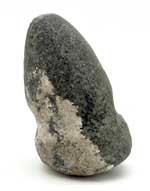 |
Grooved Hammer/Axe Head in Serpentinite. Amerind(?), c. 500 AD. This hefty tool roughly conical-shaped in profile, and oval in section, and grooved for hafting. Tool overall in good condition, with a spot of calcerous patina on one side; the stone overall a variegated dark gray-green. Length: 5-1/4".
Estimated Value $100 - 200.
View details and enlarged photo
| Realized
$242 |
Lot 848 |
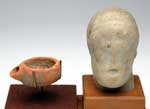 |
Lot of Two Interesting Miniatures. Ancient Near East, c. 450-150 BC. Earliest an intriguing tiny redware oil lamp -- cylindrical bowl with squarish nozzle. Judaea, c. 400 BC. Next a marble head of Herakles, carved and accurately proportioned, but lacking any details of eyes and mouth. Perhaps Alexandria, Egypt, where stone sculptures were often rough carved, and then coated with stucco for the final modeling and finish details. Circa 150 BC. Height of marble: 2-7/8"; both with custom stands. Lot of 2 items.
Estimated Value $300 - 450.
View details and enlarged photo
| Realized
$216 |
Lot 849 |
 |
Attractive Holyland Ceramic Lot. Judaea and Palestine, c. 1600-100 BC. Earliest a finely potted, well proportioned red-glazed handled jug; late Bronze Age. From the Iron Age, a neat little buff ware pot. From the Maccabaean Era, a graceful gray ware vial. Inspection suggested; all show wear, or slight repair. Largest piece: 6". A very pleasant group for display. Lot of 3 items.
Estimated Value $400 - 500.
View details and enlarged photo
| Realized
$252 |
Lot 850 |
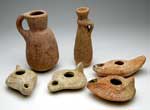 |
Holyland Ceramic Lot. Judaea and Palestine, c. 1200 BC. - 600 AD. Earliest are two juglets, a burnished redware and red banded orange ware, late Bronze Age or early to middle Iron Age. Also four late Roman or Byzantine oil lamps with simple linear or floral ornament. Inspection suggested; all show wear, or a couple with slight cracks. Largest piece: 5-1.4".A good starter lot for a young collector of Biblical antiquities. Lot of 6 items.
Estimated Value $300 - 400.
View details and enlarged photo
| Unsold |
Lot 851 |
 |
Ornate Axehead in Bronze. Northwestern Iran or Luristan, c. 1100-800 BC. A well cast bronze example having four pointed conical points and reinforcing band on the butt end. Blade is angled and slightly rounded, with semi-crescent underside, and reinforcing ridges along the edges. Raised and flaring ridges within interior of blade and along socket shaft. Intact, with green mottled patina and extensive earthen deposits. Length: 8". A less common type.
Estimated Value $650 - 950.
Cf. Moorey, "Adam Collection," no. 6.
View details and enlarged photo
| Unsold |
Lot 852 |
 |
Ceremonial Axehead in Bronze. Northwestern Iran or Luristan, c. 1100-900 BC. A well cast bronze example having four pointed conical points on the butt end. Opposing blade is sharply slanted, with semi-crescent underside, and reinforcing ridges along the edges, including the blade. Intact, with colorful overall blue-green mottled patina, with some areas of earthen encrustation. Length: 8-1/2". A fine example of series.
Estimated Value $550 - 850.
The ceremonial forms of these blades tend to be lighter castings with dull or ribbed edging to the blade area.
View details and enlarged photo
| Unsold |
Lot 853 |
 |
Larger Persian Dagger in Cast Bronze. Western Iran or Luristan, c. 12th to early 9th century BC. Another flange-hilted dagger, but handle with flap-like retainers. Of stout construction, with arrow blade having reinforcing mid-rib.Old spade mark on one side of blade, otherwise in very fine condition, with dark green and earthen patina. Length: 17-3/4".
Estimated Value $750 - 1,050.
Axel Guttmann Museum, Christies London (4-28-2004), lot 36. Compare Moorey, Adam Collection, no. 23, for another example.
View details and enlarged photo
| Realized
$920 |
Lot 854 |
 |
Ancient Persian Dagger in Cast Bronze. Northwestern Iran or Luristan, c. 12th-10th century BC. Flange-hilted dagger, the handle once set with wood or bone, with gripping indents along the sides. Narrow blade with thicker reinforcing mid-rib. Some flaking to flange, mainly at the pommel. Overall, weapon in very good condition, with variegated green and dark brown patina. Length: 13-1/4". Blade still efficiently sharp!
Estimated Value $600 - 950.
Axel Guttmann Museum, Christies London (4-28-2004), lot 36. Cf. Moorey, Adam Collection, no. 26, for closely similar example.
View details and enlarged photo
| Realized
$748 |
Lot 855 |
 |
Ornate Large Dagger Blade in Bronze. Western Iran or Luristan, c. 12th-10th century BC. The blade with broad rounded shoulder, tapering to narrow point. Both sides with raised reinforcing ridges, and short pierced tang. Blade overall very fine, the green crusty patina showing traces of of the crescentic hilt that once enclosed it. Length: 18". Attractive display piece.
Estimated Value $650 - 1,050.
Axel Guttmann Museum, Christies London (4-28-2004), lot 36.
View details and enlarged photo
| Realized
$776 |
Lot 856 |
 |
Rugged Dagger or Spear Blade in Bronze. Northwestern Iran, c. 1000-800 BC. Cast tapered blade with reinforced back, and heavy squarish midrib and tang. Intact and well preserved, with black to green patina, with slight earthen remains. Length: 11-1/2"; on custom stand.
Estimated Value $350 - 500.
View details and enlarged photo
| Realized
$219 |
Lot 857 |
 |
Large Rat-Tail Spear or Dagger Blade, in Bronze. Near East or Iran, c. 10th-7th century BC. Neatly fashioned lanceolate blade with long rat-tail tang, with thick midrib, and reinforced tip. The edges well sharpened in antiquity; the whole nicely preserved. Length: 18". A very good display piece.
Estimated Value $400 - 500.
View details and enlarged photo
| Realized
$345 |
Lot 858 |
 |
Socketed Spear Point in Bronze. Northwestern Iran, c. 1000-800 BC. Cast and wrought, the blade long and tapered, with very high midrib, swelling, rounded shoulders, and a thinner sheet socket. Chased decoration of hatched diamonds at top of socket, by blade. On socket, two sliding rings for the mounting of the blade. A little chipping to socket bottom, otherwise blade very fine with glossy dark green to matte green patina. Length: 20".
Estimated Value $500 - 850.
View details and enlarged photo
| Realized
$1,208 |
Lot 859 |
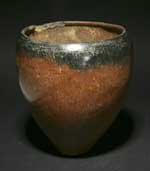 |
Black-Topped Redware Jar. Egypt, Naqada I-II Period, c. 3200 BC. Vessel tapered, with rounded conical body, having small flat base and inward turning rim. Red-brown burnished exterior surface with black collared rim. A short length of rim chips, and a small, stabilized age crack, otherwise overall excellent condition. Height: 6-1/2". Nice surface quality.
Estimated Value $700 - 950.
View details and enlarged photo
| Unsold |
Lot 860 |
 |
Lot of Two Small Dishes. Egypt, Early Dynastic or Old Kingdom, and Ptolemaic Periods, c. 2900-100 BC. Earliest a small cosmetic jar, well crafted in serpentine, of distinctive shape. Much later, a boldly molded faience dish, with wide shelf-like rim, leaf-patterned exterior and painted rosette within. Green-glazed, with small excavation number in red. Inspection suggested; all show wear, and some losses -- the jar partially burnt. Width of largest: 3-5/8". Lot of 2 items.
Estimated Value $200 - 300.
View details and enlarged photo
| Realized
$115 |
Lot 861 |
 |
Two Exceptional Glazed Items. Late New Kingdom to Ptolemaic, c. 1290-150 BC. Earliest a Ramessid scarab in beautifully glazed steatite. The insect fine and naturalistic; the base showing the king holding hands with Horus and Amun-Ra. Later, a well detailed and glazed amulet of Nephthys, sister of Isis -- perhaps early Ptolemaic, although said to have been "Found at Tel el-Amarna…". Both intact and perfect. Lengths: 3/4"; 1.-1/8". Lot of 2 items.
Estimated Value $450 - 650.
Both from a U.S. collection formed in the 1950's and 60's, with characteristic typed description cards.
View details and enlarged photo
| Realized
$265 |
Lot 862 |
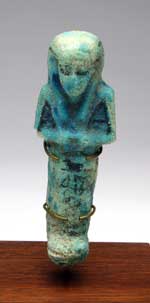 |
Small Blue and Black Ushabti. Egypt, XXI Dynasty, c. 1075-944 BC. Faience ushabti of usual simplified mummiform shape, with arms crossed, in a thick blue glaze, now faded in areas. Details of a headband, two picks, seed bag, hieroglyphs, and the eyes in an applied black glaze. Artifact is nicely preserved with only a few trivial chips to glaze. Height: 3-7/8"; on custom stand.
Estimated Value $300 - 400.
View details and enlarged photo
| Realized
$403 |
Lot 863 |
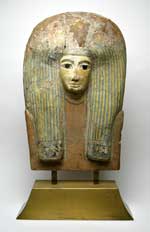 |
Impressive Female Coffin Portrait. Egypt, Third Intermediate Period, 21st-22nd Dynasty, c. 1085-800 BC. With polychrome-painted gesso over wood, the woman with huge blue and yellow lappet wig, the ends tied by colorful "jeweled bands." Her delicate features rendered in yellow, with black for the eyes, and blue for the brows. Few traces remain of the woman's shawl and beaded collar the would have covered her chest. Piece mounted in an expensive, custom display which could be hung, or set on a table. Height of object: 22-1/4". Case: 31-3/4" x 19-3/4" x 9-1/2". A very eye-catching antiquity!
Estimated Value $8,000 - 15,000.
View details and enlarged photo
| Unsold |
Lot 864 |
 |
"Classic Egyptian Eyes" - In Bronze and Stone. Egypt, Late Period to Early Ptolemaic, c. 600-250 BC. From a quality anthropoid coffin, the bronze eyebrows are nicely stylized; the bronze outlines of the eyes with extended cosmetic lines, the integral pupils also in bronze. The whites of the eyes in carved calcite. The bronze patina a crusty deep green, bordering on crystalline malachite in areas. Widths: 3-1/4", 3-1/8". An excellent set for display.
Estimated Value $1,000 - 1,500.
View details and enlarged photo
| Unsold |
Lot 865 |
 |
"Classic Egyptian Eyes" - In Bronze and Stone. Egypt, Late Period to early Ptolemaic, c. 900-400 BC. Likely from a high-quality anthropoid coffin, or perhaps a life-size wood figure. The bronze outlines of the eyes with extended cosmetic lines -- these neatly incised with minute herringbone pattern. The whites of the eyes in calcite, and inletted to receive separate pupils of glass or stone. All nicely preserved. The bronze with brown and green patina. Width: 3-1/8". Properly mounted, this high-quality set would make and intriguing display of what is perhaps the most recognizable trait of the ancient Egyptian face, the outlined eyes -- with the whites in shadow, the "pupils" of even whiter color adding mystery to the display.
Estimated Value $1,000 - 1,500.
View details and enlarged photo
| Unsold |
Lot 866 |
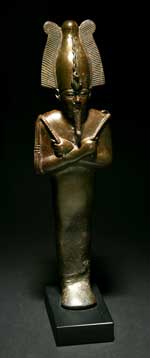 |
Impressive Museum Quality Gilt Bronze Statuette of Osiris. Egypt, Late Period, c. 664-332 BC. The bearded god in mummiform pose, standing in form fitting robe, and holding a crook and flail in his crossed hands, wearing a plumed Atef-crown fronted by an Uraeus for upper and lower Egypt, a braided false beard curves out at the chin. The figure finely proportioned, with precise detailing, and an exquisitely modeled face. Well preserved, with fine dark brown patina, preserving some traces of gold gilding. Old, well-hidden repair above ankles; also old painted collection or museum number on back. Height: 10-7/8", on custom base. Of good size, splendid and important! This is the finest bronze sculpture we have handled of this type -- absolutely perfect in every detail.
Estimated Value $40,000 - 50,000.
Morven Collection (John Werner Kluge), and Royal-Athena Galleries, New York, 1983; from Mansour Gallery, London, previously. Cf. for similar type at the Louvre in Paris (N3506) from the Clot-Bey Collection, acquired in 1852: "La crypte de l'Osiris".
Religion in ancient Egypt was an important part of everyday life. Priests daily attended to the needs of the gods (who were thought to be present in their cult images), and thus were instrumental in keeping order and normalcy in the world, not only of the present, but with an ever vigilant eye to the world of the hereafter also. Viewed from the outside, the ancient Egyptians were inordinately focused, if not obsessed, on the blessings to be enjoyed in the afterlife. As such, the deity in charge of the Underworld would of course rank among the most worthy of worship. And so, throughout the height of Egyptian civilization, Osiris was one of the primary deities. In power, he was second only his father, Ra, who was the leader of the gods on earth.
View details and enlarged photo
| Realized
$49,450 |
Lot 867 |
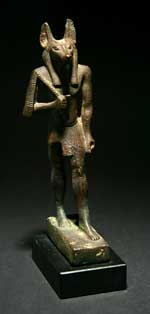 |
A Rare and Striking Bronze Sculpture of Anubis. Egypt, Late Period, c. 664-343 BC. The jackal-headed deity of mummification depicted striding forward on an integral plinth, his left leg forward, and clad in a belted pleated kilt. He is wearing a tripartite wig, broad collar, and holds a flail in his right hand. His face, muzzle and ears all finely detailed. The bronze deep brown, with occasional green and red. Discreet repair and restoration to plinth and feet. Height: 6-5/8". A superb bronze sculpture, elegant and original, without the over cleaning seen on many Egyptian bronzes.
Estimated Value $15,000 - 20,000.
Morven Collection, Christies NY (6-08-04), lot 556; with Royal Athena Galleries, NY, in 1984; from Galerie des Saints-Peres, Paris previously. Billionaire John Werner Kluge, owner of Morven Estate, near Charlottesville, Virginia, was a self-made businessman who immigrated to the United States from Germany. Kluge developed his wealth by buying and selling radio and television properties, creating the Metromedia empire. Among his art collecting passions, antiquities occupied a favored spot.
View details and enlarged photo
| Realized
$21,850 |
Lot 868 |
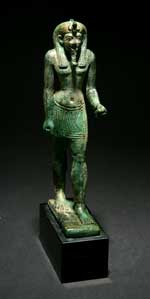 |
Superb Bronze of Striding Male Divinity. Egypt, Late Period to Ptolemaic Era, c. 600-50 BC. The idealized figure striding forward on an integral plinth, perhaps once holding a kherep-baton in his right hand and a staff in his left. He wears a short pleated kilt, wrapped tightly at the hips. The man with slightly fleshy well modelled torso, and wearing a striated tripartite wig fronted by a uraeus, along with a braided false beard. Neat, professional restoration to forward foot and front of plinth. Pleasant green patina, with much of original surfaces intact. Height: 6"; on custom base. Classic Egyptian art!
Estimated Value $9,500 - 12,500.
Morven Collection (John Werner Kluge), Christies NY (6-08-04), lot 561; with Royal Athena Galleries, NY, in 1989; from D. Zimmerman, Geneva.
View details and enlarged photo
| Unsold |
Lot 869 |
 |
Exceptional, Finely Detailed Bronze Statuette of Harpocrates. Egypt, Late Period to Ptolemaic, c. 7th-2nd century BC. A bronze statuette of the god as a seated nude small boy, with right forefinger to his lips, wearing a neck amulet, a nemes headdress with side-lock of youth and central uraeus, this surmounted by a finely detailed, broad hemhem crown (comprised of ram horns, feathers, and papyrus bundles). His feet on tenoned base. In remarkable preservation, and richly detailed. Attractive dark brown and green, with occasional red, patina. Height: 6-1/4", on custom base. A delightful little masterpiece!
Estimated Value $7,500 - 12,500.
Phocian J. Tano, in Cairo, ca. 1900; noted by him as being found at "Mentelis dans le Basse Egypte."
View details and enlarged photo
| Unsold |
Lot 870 |
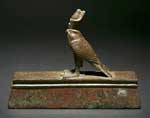 |
Well-Crafted Bronze Figure of Horus Falcon on a Shrine Base. Egypt, c. 400-300 BC. The Egyptian falcon god well modeled with chased feathering and detailing. He wears a double crown and uraeus, and stands on a hollow cavetto-corniced, rectangular shrine base. Bronze exceptionally preserved, with handsome red, brown, and green patina. Length: 6-1/2". An outstanding bronze, suitable for either private or public collections.
Estimated Value $10,000 - 15,000.
Christies, London; Property of a Lady. Cf. S. D'Auria et al., Mummies and Magic, the Funerary Arts of Ancient Egypt, Museum of Fine Arts, Boston, 1988, p. 236, no. 195 for a similar coffin.
Numerous falcon cults were scattered throughout Egypt, not all of those belonging to Horus. Nevertheless the god did have many local cults. In the Late Period and Graeco-Roman Periods falcons were mummified by the thousands and interred in sacred animal necropoleis. The bird corpses, not always complete, were tightly wrapped, often in typical mummiform drapings, and sometimes supplied with cartonnage falcon masks. The mummies could then be placed in boxes or coffins. In the Late Period bronze boxes surmounted by figures of falcons were also used to house the falcon mummies. It is these which is being replicated on a smaller scale in this modeling.
View details and enlarged photo
| Unsold |
Lot 871 |
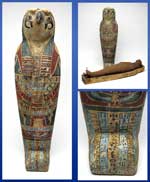 |
Highly Important Falcon Mummy & Sarcophagus. Egypt, Late Dynastic - Ptolemaic Period, c. 350-50 BC. Carved wood anthropoid mummy case, with falcon's head, gessoed and with extensive polychrome. The head with nicely painted facial markings, a lappet wig in blue-gray with jeweled ends, and a beaded broad collar. Garment motifs include: paired falcon heads with solar discs at his shoulders; two djed pillars, one with flanking uraeii; a ba bird towards the feet;and finally, over the feet are seven vertical hieroglyphic registers, alternating in blue and creme. The coffin back painted in a light tan-ocher color, with single register of glyphs along the back. The mummy with simple wrappings, with painted facial details and applied eyes -- with some splits and flaking (mostly at the beak, and one shoulder). The coffin paint with a few small areas of loss, mainly on the top of the head. Some very trivial fading in spots, but overall with very minimal wear to paint, the colors quite bold and pristine, and probably 90 per cent intact. The coffin base is little warped, but the fit is good. For being out public view for over a half century, with an absolute minimum of paint touch up (perhaps to a few glyphs at the feet), this is an extraordinarily fresh artifact, becoming less and less seen in today's market. Height: 19-1/2". A museum quality display piece.
Estimated Value $15,000 - 20,000.
Northeast U.S. Private Collection, said to have been purchased in Cairo in the early 1950's, during the time of the Farouk palace sales, and was cleared for relaese by the Cairo museum at that time. For the falcon, cf. especially one seen online at: "Life Beyond the Tomb: Animal Mummies," in the 'Australian Museum Online'; the mummy dated to the Greco-Roman Period (332 BC-392 AD), in the National Museum of Antiquities, Leiden.
As noted before, there was a large trade in mummified animals, especially in the Late Period. They were offered to pilgrims to be placed as votives in temples of the god to whom the animal was sacred. Saqqara was one of the largest centers for this practice in Egypt. Of course benefactions were expected from the donations. Often falcon mummies were given to the falcon god Horus for remedy or relief of some disease.
Under the sands of Saqqara archaeologists discovered a large cemetery complex devoted to interred animals. From the terrace of the temple built by Nectanebo II two galleries tunnel their way into the rock, one for the burials of baboons, and the second for falcons. In that part of the cemetery known as the "falcon gallery," there are miles of tunnels holding more than a million mummified falcons dating from 300 BC. to 200 AD. Interestingly, the quality and type of burials of the falcons varied greatly -- some elaborate jars were found to hold a few bones wrapped with linen, while others showed elaborate wrapping. Not all birds found were falcons though, some ibises have been noted, while some larger pots even held mummified vultures.
View details and enlarged photo
| Realized
$34,500 |
Lot 872 |
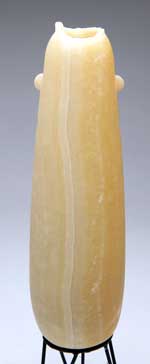 |
Pedigreed Alabaster Alabastron. Egypt, Late Period, c. 500-300 BC. Alabaster vase with long tapering ovoid body, twin vestigial handles, and narrow shoulder, the neck and mouth not preserved. The carefully crafted, thin walls of this piece accentuate the translucency and bandings of the handsome stone. Height: 7".
Estimated Value $650 - 950.
Maurice Nahman collection, noted dealer of antiquities, Cairo & Paris (1868-1948).
View details and enlarged photo
| Unsold |
Lot 873 |
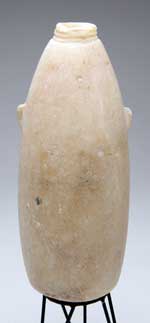 |
Pedigreed Alabastron of Carved Alabaster. Egypt, Late Period, c. 500-300 BC. The vase robust and substantial, with tapering ovoid body and carinated base, twin vestigial handles, and narrow shoulder and short ribbed neck, the mouth perhaps separately attached. Nicely crafted, the stone a very evenly colored cream-white. Faint old collection numbers on base. Height: 6-1/2". A pleasant example of type.
Estimated Value $750 - 1,250.
Maurice Nahman collection, noted dealer of antiquities, Cairo & Paris (1868-1948).
View details and enlarged photo
| Unsold |
Lot 874 |
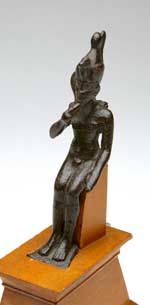 |
Harpokrates Amulet in Bronze. Egypt, Late Dynastic to Ptolemaic, c. 400-100 BC. God depicted in typical seated child pose, with one hand at side, other with finger to mouth, sidelock at head, and wearing double crown of Egypt. Feet on triangular plinth, and suspension loop at back. Nicely preserved, with chocolate brown patina, and good details. The wear to the loop shows the piece was actually worn for some time. Height: 3-3/4"; on attractive vintage mount.
Estimated Value $500 - 750.
View details and enlarged photo
| Realized
$863 |
Lot 875 |
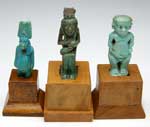 |
A Colorful Triad of Amulets. Egypt, Late Period to Ptolemaic, c. 600-100 BC. Earliest, a vividly glazed Tuart, with enormous dugs, and wearing a feathered crown. Also a very well detailed Isis and Horus, of good size, in attractive green glaze. Lastly, a very pleasantly fashioned Patek, in turquoise-colored glaze. Inspection suggested; all show wear, and two, some losses. Heights: 1-3/4" - 2". All mounted on vintage pylon-like wood bases. A handsome group. Lot of 3 items.
Estimated Value $450 - 650.
View details and enlarged photo
| Realized
$288 |
Lot 876 |
 |
Lot of Three Amulets. Late Period, c. 500-300 BC. Earliest a small very detailed, deeply colored ushabti (in either a thickly glazed steatite or glassy faience), with cartouche at waist. Also, a Tuart, the hippopatomus goddess, of usual type. Last, a neat little lion goddess in light green to blue-green faience, wearing solar crown. Inspection suggested; all repaired, two with slight losses. Heights: 1-5/8" - 2". A nice little display. Lot of 3 items.
Estimated Value $300 - 450.
View details and enlarged photo
| Realized
$360 |
Lot 877 |
 |
A Group of Attractive Figural Amulets. Egypt, Late Period to Ptolemaic, c. 600-100 BC. Earliest, a very choice Anubis, in a fairly deep turquoise glaze. And another, later, turquoise-green in color. Also a handsomely detailed Nefertum, of good size, in attractive green glaze. Lastly, an Ibis-headed Toth, in a greenish glaze. Inspection suggested; all show wear, and two, some losses. Heights: 1-1/4" - 1-7/8". All mounted on vintage pylon-like wood bases. A very handsome group. Lot of 4 items.
Estimated Value $450 - 650.
View details and enlarged photo
| Realized
$345 |
Lot 878 |
 |
Lot of Two Items, in Wood, and in Clay. Egypt, Ptolemaic to Graeco-Roman Eras, c. 300 BC. - 100 AD. Earliest is stylized wood figure of a seated falcon god, head pierced to receive crown. Simply detailed, yet its sleek form and fierce visage remains suggestive of the god's power. Perhaps from a Ptah-Seker assemblage. Ptolemaic. Also a nicely modeled horse head, with mane combed upright. Graeco-Roman. Both on custom mounts. Lengths: 5"; 2-3/4". A pleasant set. Lot of 2 items.
Estimated Value $350 - 500.
View details and enlarged photo
| Realized
$201 |
Lot 879 |
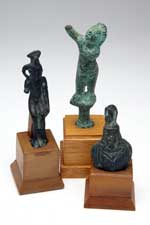 |
A Lot of Small Bronzes. Egypt, Late Dynastic to Roman, c. 400 BC. - 250 AD. Earliest, another Harpokrates amulet, as seen previously, but with different crown. Also, a detailed applique for a vessel handle: a bust of Isis, her hair worn as "Libyan " locks. Lastly, an upward reaching nude little boy -- perhaps part of a handle. Inspection suggested; all show wear, and two, some losses. Heights: 1-7/8" - 2-1/4". All mounted on vintage pylon-like wood bases. Lot of 3 items.
Estimated Value $300 - 450.
View details and enlarged photo
| Realized
$242 |
Lot 880 |
 |
Nice Pictorial and Hieroglyphic Fragment in Linen, from a Mummy Wrapping. Egypt, Late Period, c. 650-400 BC. The rectangular fragment with seven lines of hieroglyphs written in ink -- the hand quite neat and well practiced. These are part of the prayers and instructions for transporting the deceased into the afterworld. To the right, a very facile drawing of Ra or Horus seated in the solar barque. Textile laid down on board; some lacunae and bit of staining, but overall a very good sample, and very hard to get these days. Size: 4-1/4" x 8-1/2". Along with this, other samples of ancient writing. An L-shaped piece of Egyptian papyrus with seven lines of Demotic script on one side. Rare! Size: 2-1/4" x 2". Also a little section of a Coptic figural cloth border -- with what appears to be two dancing maenads. Another item is a small square of Greek-inscribed papyrus, Byzantine, c. 8th century AD. Appears to be from a ledger book, and employing numerous abbreviations. Size: 3-1/2" x 2-1/2". Lastly, a narrow rectangular palm leaf "page," southern India, c. 18th century, with numerous lines of Dravidian (Tamil) religious text on both sides. Size: 1-3/4" x 9-1/4". Inspection suggested, but overall a very good sample of ancient writings. Lot of 5 items.
Estimated Value $850 - 1,650.
View details and enlarged photo
| Realized
$2,640 |
Lot 881 |
 |
Fine White Handled Bowl. Cyprus, Late Bronze Age I, c. 1600-1450 BC. Delicately potted in hemispherical form, with wishbone-like handle. The slip now creme color, with vertical bands of lattice work designs around. With similar borders around the rim and along the handle. Bowl exceptionally preserved, with a few minor scrapes at the rim. The interior evenly covered with light root marks. Width: 8-7/8".
Estimated Value $500 - 850.
Cesnola Collection duplicate from the Metropolitan Museum of Art, 1896. Ex Stanford University Museum de-accession no. 3129, 1968. Old inked inventory numbers on interior. Thes are often referred to as "milk bowls."
View details and enlarged photo
| Realized
$288 |
Lot 882 |
 |
Attic or South Italian Black-glazed Lebes. Greek, c. 400-300 BC. Vessel of semi-ovoid shape on short flaring foot, with distinctive upright handles, plus six conical projections (with two on the handles). With excellent glossy glaze, just a touch metallic. Vessel in choice condition, with only a little old, unobtrusive paint touch up to scattered tiny peck marks in glaze, plus a few spots of rubbing on the handles. Height: 8-1/4". A handsome vessel type.
Estimated Value $950 - 1,450.
View details and enlarged photo
| Unsold |
Lot 883 |
 |
Charming Footed Dish. Magna Graecia; Apulia, Messapian, c. 5th century BC. A moderately coarse orange ware on a high foot with vestigial spool handles. Dish finished in white glaze, with ornament in red-brown -- neat geometric patterning, a central star in tondo, with paired keys in quarters. Intact with medium wear. Width: 5-3/8".
Estimated Value $300 - 400.
View details and enlarged photo
| Unsold |
Lot 884 |
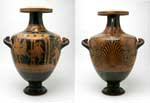 |
Museum Quality Redware Hydria with Mythological Scene. Magna Graecia, Apulia, c. 390-340 BC. The vessel finely potted, with flaring foot in three degrees, three handles, and contoured overhanging rim. The minor field decorations handled confidently and neatly. The figurative devices of superb quality -- certainly equal to the best contemporary Attic painters. Side A: An armed youth on horse contends with a sword-wielding youth on foot, both within a temple naiskos. To the left, above and behind the horseman, another stands as backup; similarly to the right, two older bearded warriors support the youth. The scene framed by a curved palm tree on either side. Side B: Ornate arabesque of palmettes. Added details highlighted in white and yellow. Vessel reassembled from numerous pieces, with academic (non-painted) restorations typical of the early 20th century. Paint preservation and surfaces overall are superb. Height: 17-3/4". An outstanding work of art, and one of the best vases we have handled over the years.
Estimated Value $9,500 - 12,500.
Reminiscent of the figural groups by the Hoppin painter, but with a neater, more precise hand. With the old restorations removed and vessel properly repaired, the value of the hydria could easily climb to the $20,000-$25,000 range. It is that fine.
View details and enlarged photo
| Realized
$18,400 |
Lot 885 |
 |
Pan-Athenian Amphora in Red-Figure Technique. Magna Graecia, Apulia, c. 340-310 BC. Vessel of fairly narrow shape, with raised foot, twin handles, and broad mouth. Vessel of pinkish-tan clay, with red wash and black glaze. One Side A: a woman of fashion standing right, before Eros, who is seated left on rocks and holding out a decorated box. Side B: two cloaked youths facing each other; large palmettes on either side. Other details are picked out in white and yellow-ochre. Vessel in excellent condition, and free of repairs. Height: 18-5/8". A handsome Apulian ceramic from the Age of Alexander the Great.
Estimated Value $3,000 - 4,000.
View details and enlarged photo
| Realized
$3,565 |
Lot 886 |
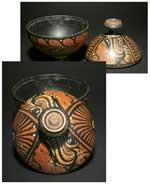 |
Boldly Painted Globular Pyxis. Magna Graecia, Apulia, c. 320-310 BC. The spherical vessel with raised foot and knob handle, and covered in red wash with black glaze on top. Lid with two heads of "Ladies of Fashion," and palmettes between. Base with wide wreath border, and narrow wave pattern beneath. Added details pick out in yellow and white. Repaired from a few large pieces, with small area of restoration to rim of base. Overall, vessel finely preserved, with excellent surfaces and paint. Base and lid fit loosely; perhaps due to warping during firing, or they come from two different vessels. Height: 6-5/8". A flashy example of its class.
Estimated Value $1,200 - 1,500.
Probably the circle of the White Sakkos Painter.
View details and enlarged photo
| Unsold |
Lot 887 |
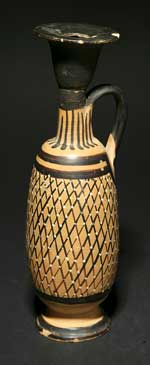 |
Well-Painted "Net Bottle." Magna Graecia, Apulia, c. 350-320 BC. The vessel a slim lekythos, with footed oval body, single handle, and broad rimmed mouth for application. Mouth, handle, and rim of foot in black, with like petals at neck. Body covered with crisscross pattern, with white dots at the intersections. A few minor chips to mouth and foot, and repair to neck, otherwise vessel finely preserved, with excellent surfaces. Height: 7".
Estimated Value $450 - 750.
View details and enlarged photo
| Realized
$575 |
Lot 888 |
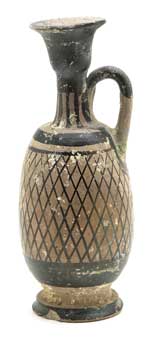 |
Southern Italian Lekythos. Magna Graecia, c. 300 B.C. Nearing a squat lekythos in form, criss-cross lines in black decorate the vessel, which retains some of its encrustation. Height: 6 1/2 ". Substantial repairs at neck and lip.
Estimated Value $350 - 450.
View details and enlarged photo
| Realized
$230 |
Lot 889 |
 |
Southern Italian Lekythos. Magna Graecia, c. 320 B.C. Decorated with vine leaf and geometric patterns, this terracotta lekythos is painted in black and is reminiscent of the earlier Attic model. Height: 7.8 inches. Lacking some of its ornamentation but not overly restored, the piece retains much of its original character. A few minor chips on base, as can be expected.
Estimated Value $300 - 450.
View details and enlarged photo
| Realized
$230 |
Lot 890 |
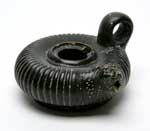 |
Attractive Caelene-Ware "Feeder." Magna Graecia, Apulian or Campanian, c. 340-310 BC. A guttus-like vessel, with nipple-shaped spout for feeding infants. With vertical ribbing, stamped floral border, and a spout molded into a charming lion's head. The open discus notched, to take a removable (strainer?) cover. Repaired, with discreet trivial restoration and paint touch up. Length: 4-1/2". A charming, less typical example of its class.
Estimated Value $400 - 550.
Cf. another example, currently with Royal-Athena Galleries, no. CBA27, cruder, but complete with cover for discus.
View details and enlarged photo
| Unsold |
Lot 891 |
 |
Daunian-ware Buff-colored Askos. Southern Italy, Apulia, 325-225 B.C. Decorated in brown, this is a form not often encountered. Rhomboids, concentric circles and stripes abound. Height: 6.3 inches. Moderate restoration.
Estimated Value $300 - 400.
View details and enlarged photo
| Unsold |
Lot 892 |
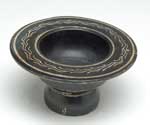 |
Footed Teano Ware Bowl. Magna Graecia, Campania, c.330-300 BC. The dish with steep-walled sides and wide flat rim -- the whole with fine glossy black glaze. On the rim, sgrafitto vine pattern between two impressed borders, all with original red color within the recesses. Intact and very fine, with only light wear to the glaze evident mainly on the exterior edges. Height: 2-1/4"; Width: 4-1/2".
Estimated Value $300 - 400.
Ex Superior Fine Antiquities, March 12, 1994, lot 333.
View details and enlarged photo
| Realized
$345 |
Lot 893 |
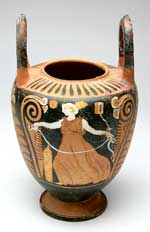 |
Paestan Red-Figure Lebes. Magna Graecia, Lucania, ca. 325-310 B.C. Vessel of semi-ovoid shape, on short flaring foot with distinctive upright handles, in red wash and black glaze. One side shows woman advancing left while holding long fillet; the reverse with cloaked youth standing left, with large palmettes flanking on either side. Woman's flesh and other details picked out in white and yellow-ochre. Vessel in choice condition, free of repairs, and with only minor paint touch up to one arm. Height: 8-7/8". Quite attractive and appealing for this class of pottery.
Estimated Value $1,750 - 2,250.
View details and enlarged photo
| Realized
$1,955 |
Lot 894 |
 |
Molded Terra Cotta Figurine of Athena. South Italian or Sicily, c. 300-150 BC. The goddess helmeted, wearing high-girt peplos, and leaning against column, all on high base. She stands on one foot, one hand raised to likely hold a spear. The other hand truncated, probably to receive a separately applied shield, now missing. Complete as is, and without any apparent repairs, the goddess covered with earthen patina, with traces of white pigment at the head, and red at the base. Height: 8-3/4"; on custom stand. Rare in this condition!
Estimated Value $1,900 - 2,600.
View details and enlarged photo
| Unsold |
Lot 895 |
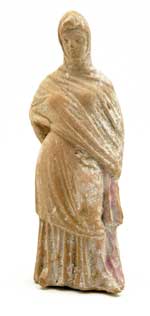 |
Delightful Terra Cotta of Draped Woman. Hellenistic Greece, c. 3rd-2nd century BC. Sharply molded from a pinkish-orange fine grain clay, the image is of a young woman, veiled, standing with her weight resting on one foot, and one hand behind her back. The contrapasto modeling between the drooping shoulder and upward thrusting hip masterfully conveyed. One foot chipped, plus a discreet repair around one leg, the piece otherwise finely preserved, with hints of coloring. Height: 4-5/8". Sweet art!
Estimated Value $650 - 850.
View details and enlarged photo
| Realized
$575 |
Lot 896 |
 |
A Quality Illyrian Helmet in Bronze. Illyria, c. 550-400 BC. Of high domed form with long triangular cheek guards and rectangular face opening, and everted neck flange. The crown with two raised parallel ridges; inbetween, three parallel incised lines. Entire exterior edge perimeter engraved with row of small dots between narrow borders. Overall with pleasant green and dark green patina with scattered brown. Professional repair and reinforcement to neck flange, otherwise helmet choice and free of the often considerable restoration usually seen on these. Height: 11". A very fine example of a Greek helmet.
Estimated Value $15,000 - 17,500.
This helmet a mate to that formerly in the Melvin Guttmann Museum; cf. Christies London (4-28-2004), lot 73. Same workshop?
View details and enlarged photo
| Realized
$14,950 |
|
|